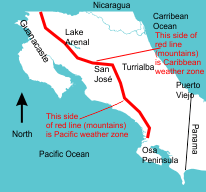Costa Rica Weather
 Costa Rica's weather is controlled by two oceans and a central dividing mountain range that creates surprisingly distinct weather -- and climate -- zones. The north and east zone is called the "Caribbean weather zone" (even though parts of that zone -- the Osa Peninsula --are on the Pacific coast) and the "Pacific weather zone" (which includes most of San José and the Central Valley).
Costa Rica's weather is controlled by two oceans and a central dividing mountain range that creates surprisingly distinct weather -- and climate -- zones. The north and east zone is called the "Caribbean weather zone" (even though parts of that zone -- the Osa Peninsula --are on the Pacific coast) and the "Pacific weather zone" (which includes most of San José and the Central Valley).
The Pacific Weather Zone
The Pacific zone has a very distinct dry season (mid December thru early April) and wet season (July thru November). During the dry season it's clear skies and hot -- daily temperatures on the beaches regularly reach 90°F (32°C) and intense sunshine. March and April are the hottest months. San José is spared the highest temperatures because elevation (3800 ft or 1100 meters MSL) and spillover cooler air from the Caribbean zone nearby (the Continental Divide is between San José and Volare, 26 miles away).
Rainy season in the Pacific Zone often means really big rains, with roads closed and coastal storms knocking out power and downing big trees. The mountain slopes facing the Pacific have stunted trees (the rainforest giants don't survive well in dry season or wind) and are covered in short dry grasses ("chaparral"), similar to southern California. North Guanacaste is the driest and windiest part of Costa Rica, and the area crops (melons, mangoes, rice) rely heavily on irrigation. The irrigation water comes from the Caribbean Zone, from rivers diverted to Lake Arenal which then pass into Guanacaste.
The Pacific weather zone is home to popular beach destinations - Dominical, Manuel Antonio, Jaco, Tamarindo and the Nicoya and Guanacaste coastline.
Months not in wet or dry season are unpredictable... or actually, very predictable if you understand the effects of "El Niño" or "La Niña", weather phenomena involving ocean surface temperatures which affect the whole world's rain patterns.
Caribbean Weather Zone
The Caribbean Weather Zone is overall more mild, both in temperatures (rarely reaches 88°F. / 31°C). Monthly variation in precipitation is remarkably little. As a result the Caribbean weather zone is always lush, always green, so is home to big rivers (like the Pacuare), rain forest and cloud forests (high altitude rain forest with a completely distinct set of plants and animals). The mountain slopes are covered in giant rainforest trees. Low and soft clouds form usually in mid morning and protect crops and people from intense sunshine (and produce dramatic sunsets). The Caribbean weather zone is the breadbasket of Costa Rica - vegetables, dairy, sugar, meats - as well as tourism centers like La Fortuna (Arenal Volcano), Tortuguero, Turrialba, Osa Peninsula.
(Coffee is a high altitude crop and grows in both the Caribbean and Pacific weather zones.)
TEMPORALS are storms that arrive and stay in an area for 3 to 5 days. There are no trade winds this close to the equator, so nothing pushes weather along. Temporals happen any time of the year, in all parts of Costa Rica, unpredictably.
HOW TO DRESS Few people in Costa Rica have raincoats; people use umbrellas instead. Rain comes and goes intermittently during even the rainiest periods and even in the driest periods. Be ready to dress in layers. The higher the altitude, the cooler the air temperature, and usually windier, too. Volare is comfortable with a wind blazer and fleece in even the wettest times.